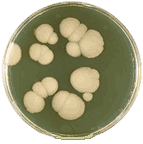Papers in the Biological Sciences
Document Type
Article
Date of this Version
2013
Citation
FEMS Yeast Res 13 (2013), pp. 529–539.DOI: 10.1111/1567-1364.12056.
Abstract
Candida albicans is an opportunistic fungal pathogen in humans. It is a polymorphic fungus: it can live as yeasts, hyphae, or pseudohyphae. Biotin is required for cell growth and fatty acid metabolism because it is used as a cofactor for carboxylases such as acetyl-CoA carboxylase, and pyruvate carboxylase. In addition, we have discovered that biotin is used to modify histones in C. albicans. Biotinylation was detected by Western blots using a monoclonal antibiotin HRP-conjugated antibody as well as with qTOF and LC/MS/MS mass spectrometry. As a precaution, the antibiotin antibody was dialyzed against neutravidin prior to use. During this study, we observed that three histones, H2A, H2B, and H4, were biotinylated at many lysine residues in an apparently nonsite-specific manner. Roughly, equivalent levels of acetylation, methylation, and phosphorylation were found in histones from biotin-replete and biotin-starved cells, but histone biotinylation was only observed for cells grown in excess biotin. The function of histone biotinylation in C. albicans is still unknown but, because C. albicans is a natural biotin auxotroph, a storage reservoir for biotin is attractive. Techniques used to detect histone biotinylation in C. albicans did not detect any histone biotinylation in Saccharomyces cerevisiae.
Included in
Environmental Microbiology and Microbial Ecology Commons, Other Life Sciences Commons, Pathogenic Microbiology Commons



Comments
Copyright 2013 Federation of European Microbiological Societies. Used by permission.